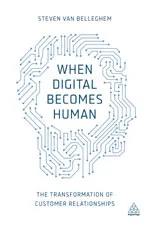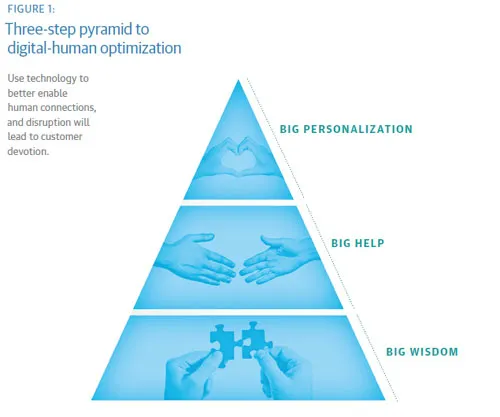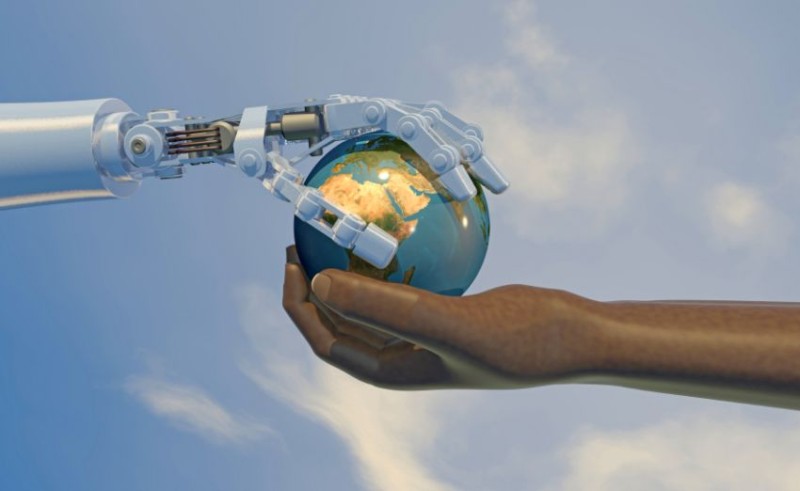Digital technologies dominate strategic innovation discussions, as consumers gravitate toward online and mobile platforms for more of their brand interactions. As customer behaviors change, brands must reevaluate their approach to marketing and engagement to remain in line with evolving expectations. To keep up, brands must establish programs that support both the digital and human sides of the customer relationship.
Steven Van Belleghem, author of When Digital Becomes Human, says it’s important for companies to determine precisely what’s driving companies to embrace digital, and how they can enable such a future.
Customer Strategist: How have customers become the biggest disruptors within the digital space?
Steven Van Belleghem: One reason is speed. The external clock is ticking faster than the internal clock. Customers can switch overnight if they want, but companies need to change the course of a bigger ship, which is harder. The challenge is to follow up on this speed. Facebook is a great example. When Facebook IPO’d, the feedback was negative because Facebook hardly made any money in the mobile world. That was 2012. In 2014, most of Facebook’s revenue came from the mobile world. They changed the ship at high speed and because of that, they are extremely successful. Customers disrupt because companies are slower than the market.
Another reason is the collaborative movement. A lot of these new popular companies are all active in the collaborative sphere, where customers are helping out other customers. Everyone’s aware of the well-known examples like Uber, but the truth is that we have thousands of those companies around in many sectors. The collaborative economy gives a more personal side to business. It makes it more human. In this digital world, the human part of business is increasing in value. The old economic law of scarcity pops up: If something becomes scarce, it increases in value. Well, the human part of business is becoming scarce. That’s one of the reasons why the collaborative economy has so many fans. That’s why consumers are disrupting normal market movement.
CS: Why is customer centricity so critical as the business world becomes more digital and mobile?
SVB: Digital actually means customer first without compromise. Technology is making our lives a lot easier and, even more, technology itself has become very intuitive and easy to use. So now the expectation level of customers increases every single day.

Companies can create a new, more extreme form of customer centricity—a customer relation in which they use the strengths of the digital world (automation, convenience, etc.) and the strengths of the real human interface (emotion, empathy, and creativity). If companies understand the strengths of both dimensions, they will surprise their customers in a very positive way. Customers want both convenience and emotion. Digital and humans are not fighting; they each have different strengths that add value for the customer. In this digital world, we need to be good in both to win the heart and actions of the customer.
CS: In your book, you claim that technology has become our sixth sense. What does this mean, and what are the implications for different industries?
SVB: In the last 200 years, innovations were created to overcome the physical limitations of people. We need cars because we are not fast enough. We need machines because we are not strong enough. Today’s and tomorrow’s innovations are here to overcome the mental limitations. Our phones are already our external memory. Once we have more mainstream chips for people, technology will also be part of our body. At that point, technology really will be our sixth sense.
This evolution will change healthcare dramatically, in particular. We will evolve from a reactive to a proactive healthcare system. It’s not about making people better anymore. It’s about preventing people from becoming ill. The same will happen in the business world. Once everything is connected, consumers will expect a faster than real-time customer service. If products become smart, they will know upfront when they will break down. At that moment, consumers will expect a solution before they discover the problem.
CS: Some people predict an all-digital future for customer interactions. You don’t agree. Why not?
SVBroWe are approaching an era of ‘human-like’ customer service. An era where it will be very hard to tell the difference between the digital and the human interface. Consumers may even like the digital interface more than the human one, as the digital interface will be faster, more up to date, and possibly even more friendly. On the other hand, people still like to connect with real people. Especially when something goes wrong, we like to have human back up. Even a company like Amazon now has the ‘Mayday’ function on Kindle. Mayday connects customers with a human employee from Amazon. From a distance, the Amazon employee is helping out the customer. The goal is to resolve issues, not just make everything digital.
CS: Are there any other examples of companies that successfully integrate the digital and human world?
SVBamWalt Disney World is a great example. Since 2014, 50 million visitors each year have used MyMagic+, a new type of holiday management system, in which the customer occupies a central position between a wide range of state-of-the-art contact options. The key element in the concept is the ‘MagicBand.’ Every visitor receives an armband with an integrated Mickey Mouse logo. This armband allows them, among other things, to open their hotel rooms, enter the amusement park, make payments, etc.
The MyMagic+ concept is brilliant. It is improving customer experience, it is creating more business value for Disney, and it is creating the smartest database ever built by a large corporation. The online and offline boundaries disappear when you are in Disney World. In my opinion, if you want to know what the future could be like in the entire world five years from now, book a holiday at Disney World. Once you have lived it, you won’t want anything else. In Disney World, you also understand right away that consumers don’t care about privacy if the experience is fantastic. Disney created a system where data and connectivity improve the customer experience.
CS: How can companies enable similar initiatives?
SVB: For the customer, it’s about Big Data, which is all about big relevance. Modern consumers expect to receive some form of added value in return for all the data they provide. To ensure that they get it, a three-step pyramid model shows how data can be used to heighten customer relevance across digital and human channels (see Figure 1). And when you use technology to better enable human connections, disruption will lead to customer devotion.


















